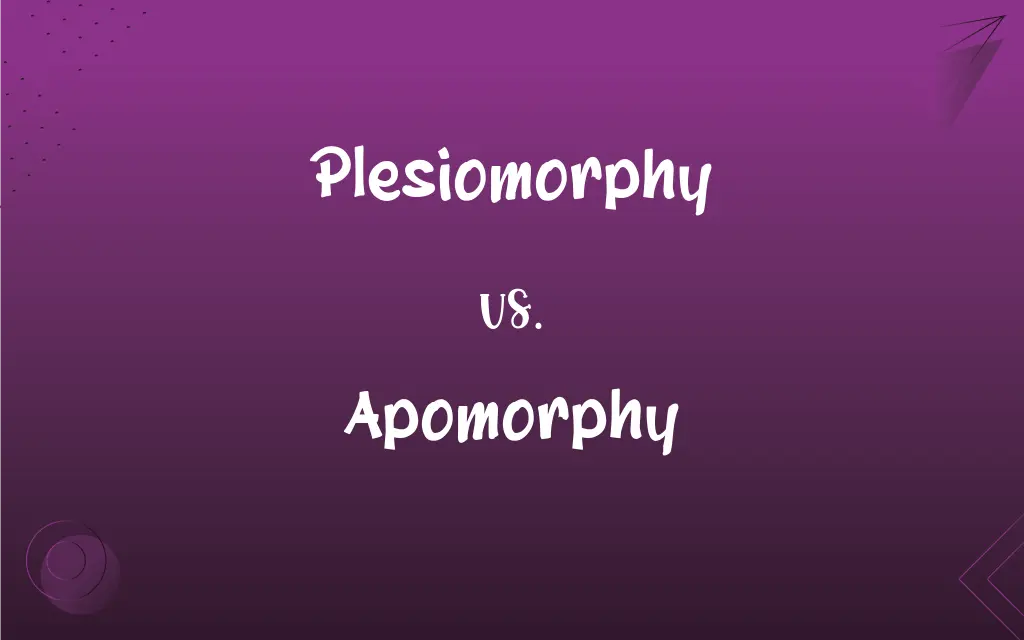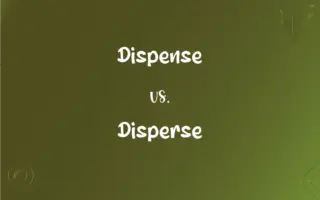Plesiomorphy vs. Apomorphy: What's the Difference?
Edited by Janet White || By Harlon Moss || Updated on November 7, 2023
Plesiomorphy refers to an ancestral trait shared by multiple species, whereas apomorphy signifies a derived, newer characteristic unique to a particular lineage.

Key Differences
Plesiomorphy and apomorphy are terms used in cladistics to describe characteristics in species. A plesiomorphy is an ancient characteristic that is present in an ancestral form, which can be seen in various descendants. It is a trait that has been inherited without much change from a common ancestor.
Apomorphy, in contrast, is a newer, derived trait that has arisen in a species and is not present in the ancestor. This term is used to describe a feature that distinguishes a certain group of organisms from others. Apomorphies are considered evolutionary innovations.
While discussing plesiomorphy, we look into the past to identify traits that have been passed down through evolutionary time. These traits are not useful for determining a specific evolutionary relationship because they are shared across different groups.
Apomorphy, on the other hand, is a trait that can be used to define a specific evolutionary relationship. It is these derived characteristics that taxonomists use to identify how closely related certain species are within a group.
Plesiomorphy connects different organisms by their shared, ancestral states, indicating a more distant common ancestry. Apomorphy provides a way to recognize and classify the evolutionary paths that have led to the emergence of new traits in a lineage.
ADVERTISEMENT
Comparison Chart
Definition
An ancestral trait shared by many species
A derived trait unique to a specific group
Evolutionary Age
Ancient, unchanged from an ancestor
Newer, evolved after diverging from an ancestor
Taxonomic Use
Less useful for defining relationships
Useful for defining specific relationships
Indicative Of
General common ancestry
Specific lineages or evolutionary change
Example
Vertebral column in mammals
Opposable thumbs in primates
ADVERTISEMENT
Plesiomorphy and Apomorphy Definitions
Plesiomorphy
An ancestral trait found in multiple descendants.
The presence of gills in fish and embryos of terrestrial vertebrates is considered a plesiomorphy.
Apomorphy
A recent evolutionary trait distinguishing a lineage.
The elongated neck of a giraffe is an apomorphy distinguishing them from other ungulates.
Plesiomorphy
A trait inherited from a distant common ancestor.
The pentadactyl limb structure is a plesiomorphy among many tetrapods.
Apomorphy
A new trait not found in a group's immediate ancestor.
The development of a four-chambered heart is an apomorphy in mammals.
Plesiomorphy
A primitive feature retained over evolutionary time.
Bilateral symmetry is a plesiomorphy seen across numerous animal phyla.
Apomorphy
A derived characteristic that evolved within a specific group.
Feathers are an apomorphy unique to birds among vertebrates.
Plesiomorphy
An old characteristic present in both ancestors and modern species.
The backbone is a plesiomorphy shared by all vertebrates.
Apomorphy
An innovative feature arising in a particular clade.
The loss of limbs in snakes is an apomorphy that separates them from other reptiles.
Plesiomorphy
A shared ancestral trait that is not newly evolved.
Flowering plants exhibit several plesiomorphies from their gymnosperm ancestors.
Apomorphy
A unique characteristic used to define a clade.
The presence of a marsupial pouch is an apomorphy defining marsupials.
Plesiomorphy
An evolved character or trait that is shared by some or all members of a phylogenetic group and their common ancestor but is not unique to that group. A segmented spinal column is a plesiomorphy of mammals, being present as well in other groups such as fishes, reptiles, amphibians, and birds.
Apomorphy
An evolved character or trait unique to a particular phylogenetic group of organisms. The vertebral column is an apomorphy of vertebrates.
Plesiomorphy
(cladistics) A character state that is present in both outgroups and in the ancestors
Apomorphy
(systematics) A derived characteristic of a clade. Any feature novel to a species and its descendants.
FAQs
Can a plesiomorphy become an apomorphy?
No, plesiomorphy always refers to ancestral traits, while apomorphy refers to derived traits.
What is a plesiomorphy?
A plesiomorphy is an ancestral trait shared by multiple species.
Are plesiomorphies useful for building phylogenetic trees?
They are less useful because they do not indicate specific evolutionary branches.
What is an example of an apomorphy?
The presence of feathers in birds is an apomorphy.
Why are apomorphies important in cladistics?
Apomorphies help to determine evolutionary relationships and define clades.
What is an example of a plesiomorphy?
The vertebral column in mammals is a plesiomorphy.
Is a plesiomorphy shared by all members of a clade?
Yes, it is shared by all members that descend from a common ancestor.
What's a synapomorphy?
A synapomorphy is a shared apomorphy that defines a clade.
What does apomorphy mean?
An apomorphy is a derived trait that is unique to a particular lineage.
Can one organism have both plesiomorphies and apomorphies?
Yes, organisms can have a mix of ancestral and derived traits.
Is a trait's age relevant to whether it's a plesiomorphy or apomorphy?
Yes, plesiomorphies are older traits, while apomorphies are newer, derived traits.
Do apomorphies evolve from plesiomorphies?
Apomorphies may evolve from plesiomorphies or from previous apomorphies.
Can plesiomorphies be lost over time?
Yes, through evolutionary processes, ancestral traits can be lost.
Is it possible for a plesiomorphy to become more complex over time?
Yes, plesiomorphies can become more complex, potentially giving rise to apomorphies.
Why is distinguishing between plesiomorphy and apomorphy important?
It's important for understanding the evolutionary history and relationships among species.
How do scientists identify an apomorphy?
By finding traits that have evolved in a lineage after it has branched off from its ancestors.
Can the same trait be a plesiomorphy in one context and an apomorphy in another?
Yes, depending on the reference group, a trait can be seen as a plesiomorphy or apomorphy.
How do scientists identify a plesiomorphy?
By comparing species and identifying common traits that existed in their ancestors.
Are plesiomorphies considered evolutionary advancements?
No, they are considered ancestral and not advancements.
Does an apomorphy appear in all descendants of a clade?
An apomorphy appears only in the members of a clade where it originally evolved.
About Author
Written by
Harlon MossHarlon is a seasoned quality moderator and accomplished content writer for Difference Wiki. An alumnus of the prestigious University of California, he earned his degree in Computer Science. Leveraging his academic background, Harlon brings a meticulous and informed perspective to his work, ensuring content accuracy and excellence.
Edited by
Janet WhiteJanet White has been an esteemed writer and blogger for Difference Wiki. Holding a Master's degree in Science and Medical Journalism from the prestigious Boston University, she has consistently demonstrated her expertise and passion for her field. When she's not immersed in her work, Janet relishes her time exercising, delving into a good book, and cherishing moments with friends and family.































































